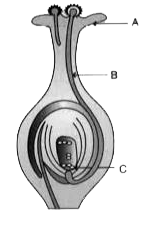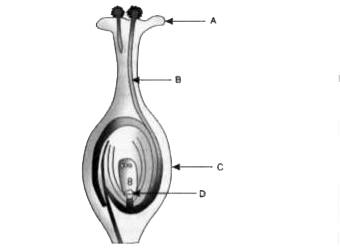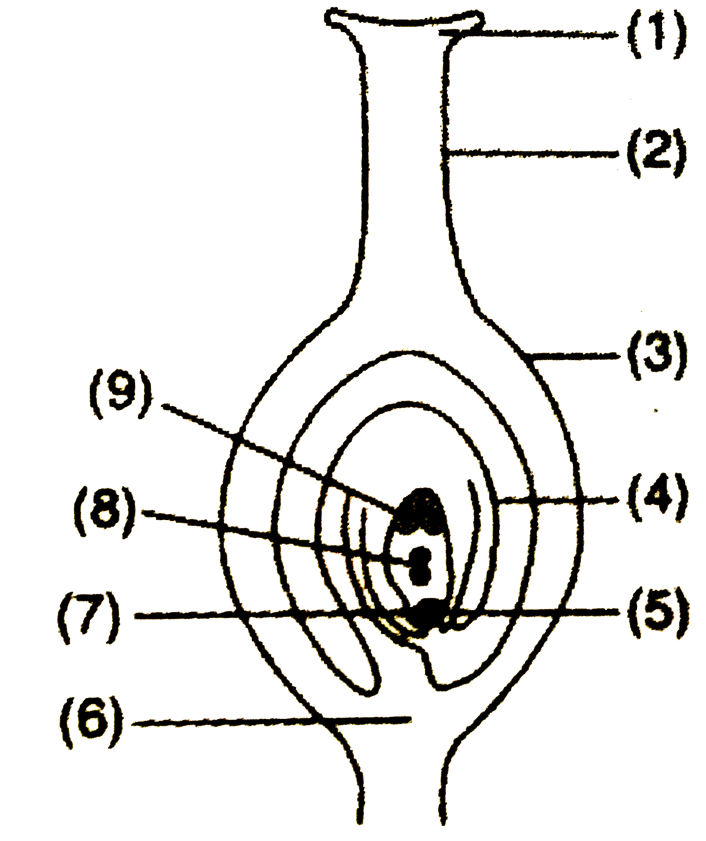a Name the parts labelled as A B C and D in the diagram given belowb What is pollination ? State its significance.c How does fertilisation occur in flowers ?Name the parts of the flower that develop into i seed and ii fruit after fertilization.
i Diagram from next page in the given figure A represents the pollen grainB represents the pollen tubeC represents the ovuleD represents the male germ cellsii The transfer of pollen grains from the anther to the stigma of a flower is known as pollination.Significance of pollination :a It is a significant event because it precedes fertilization.b It brings the male and female gametes closer for the process of fertilization.c Cross-pollination introduces variations in plants because of the mixing of different genes. These variations further increase the adaptability to plants towards the environment or surroundings. iii Double fertilization is a characteristics feature of flowering plants. In this process out of the two sperm nuclei one sperm nucleus fuses with the egg nucleus to form an embryo process is called syngamy and another fuses with the polar nucleus to form an endosperm process is called triple fusion. Because two kinds of fusion—syngamy and triple fusion—take place the process is known as double fertilisation. After fertilisation i the ovule develops into a seed.ii the ovary develops into a fruit.
Related Solutions
Name the parts A, B and C shown in the diagram and write their functions.
 View Solution
View Solution(a) Identify A, B, and D in the given diagram and write their names.

(b) What is pollination? Explain its significance.
(c) Explain the process of fertilization in flowers. Name the parts of the flower that develop after fertilization into
(i) seed,
(ii) fruit.View Solution(a) What is pollination ? State its significance (b) How does fertilisation occurs in flowers ? Name the parts of the flower that develop into (i) seed and (ii) fruit after fertilisation.
View SolutionName the parts of flower that develop after fertilization into (i) Seed (ii) Fruit
View SolutionName the part of the flower which develops into fruit and seed after fertilization.
View Solution(a) What is meant by 'unisexual flowers' and 'bisexual flowers' ? Give two examples of each.
(b) What is pollination ? How does pollination occur ?
(c) Describe the process of fertilisation in a flower with the help of labelled diagrams.
(d) What changes take place in the flower after fertilisation which lead to the formation of seeds and fruit ?View SolutionAfter fertilization in flowering plants, seeds bearing embryos are found inside the fruits. If seeds are developed from ovules, Name the parts that given rise to embryo and fruits.
View Solution(a) Draw a diagram showing germination of pollen on stigma of a flower and mark on it the following organs/parts:
(i) Pollen Grain
(ii) Pollen tube
(iii) Stigma
(iv) Female germ cell
(b) State the significance of pollen tube.
(c ) Name the parts of flower that develop after fertilisation into
(i) Seed (ii) FruitView SolutionThe part of the flower"Which develops into fruits after fertilization
View SolutionWhich part of the flower turns into a fruit after fertilization? (Which part of the flower turns into a fruit after fertilization?)
View SolutionThe given diagram shows the carpel of a flowering plant. After fertilization , many structures undergo change to produce parts of fruit/seed. Fruit wall, embryo, endosperm and seed coat are shown in the diagram labelled respectively as
 View Solution
View SolutionThe given diagram shows the carpel of a flowering plant. After fertilization , many structures undergo change to produce parts of fruit/seed. Fruit wall, embryo, endosperm and seed coat are shown in the diagram labelled respectively as
View SolutionDistinguish between unisexual and bisexual flowers giving one example of each.
Draw a neat diagram showing fertilisation in a flower and label:
a] Pollen tube
b] Male germ cell
c] Female germ cell, on it.
OR
Draw the diagram showing the germination of pollen on stigma and label the part on which pollination takes place.
Answer the following questions based on diagram given aside.
i] Name the part marked 'P. in the diagram.
ii] How does 'P. reach part 'B'?
iii] State the importance of the part 'C'.
iv] What happens to the part marked 'D' after fertilisation is over?
Mention the role of gamete and zygote in sexually reproducing organisms.
 View Solution
View SolutionDistinguish between unisexual and bisexual flowers giving one example of each. Draw a neat diagram showing fertilisation in a flower and label: a] Pollen tube b] Male germ cell c] Female germ cell, on it. OR Draw the diagram showing the germination of pollen on stigma and label the part on which pollination takes place. Answer the following questions based on diagram given aside. i] Name the part marked 'P. in the diagram. ii] How does 'P. reach part 'B'? iii] State the importance of the part 'C'. iv] What happens to the part marked 'D' after fertilisation is over? Mention the role of gamete and zygote in sexually reproducing organisms.
View SolutionPart of the flower that develops into fruit and part of the seed that develops into root respectively are
View SolutionPart of the flower that develops into fruit and part of the seed that develops into root respectively are
View SolutionAssertion (A): Fertilization in flowers, produces fruits and seeds.
Reason (R): After fertilization the ovary develops into fruits and ovule develops into seed.View SolutionAfter fertization in flowering plants seeds bearing embryos are found inside the fruits. If seeds are developed from ovules. Name the parts that give rise to embryo and fruits.
View SolutionAssertion : Pollination and fertilization in flowers produces fruits and seeds. Reason : After fertilization the ovary becomes fruit and ovule becomes seed.
View Solutionनिषेचन के बाद पुष्प का कौन-सा भाग फल में बदल जाता है ?
View Solution
